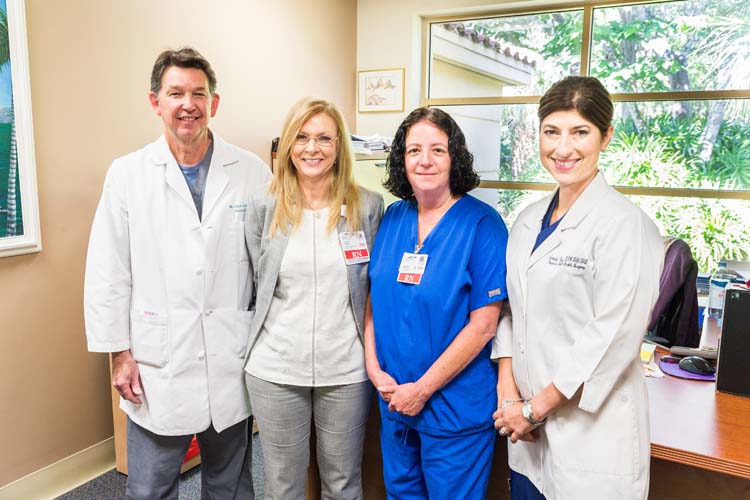
If you have a diabetic leg or foot wound, you’ve got a lot friends.
Unfortunately, they’re not the kind of friends anyone really wants.
They’re bacteria.
Some 160 different types of bacterial pathogens with names like “staphylococcus aureus” and “beta-hemolytic streptococci” live, eat and breed inside such wounds, and you are their primary food source and life-support system.
Working to get rid of these unwelcome guests is a large part of what vascular surgeon Dr. W. Clark Beckett and podiatric surgeon Dr. Amberly Paradoa – along with nurse-manager Debbie Dill and program director Carrie Duprey – do every day at the Indian River Medical Center’s wound healing center.
The center uses a wide range of techniques, treatments and technology to help people heal and manage persistent wounds.
The American Podiatric Medical Association estimates more than 21 million Americans have been diagnosed with diabetes, and the Centers for Disease Control says upwards of 15 percent of those diabetic patients will develop ulcers or open wounds on one or more of their extremities.
Diabetic foot ulcers are considered to be the most common as well as the most disabling and costly complication of diabetes. Each year those ulcers are directly responsible for upwards of 80,000 amputations nationwide.
“Wound care,” says Beckett, “is hard work. It’s week after week and we see patients every week. Numbers increase, volumes increase,” and it’s definitely not for the faint of heart.
The soft-spoken Beckett continues, saying “a wound or an ulcer that first presents to us may be very shaggy and ugly with a lot of dead tissue, so it’s anesthetized and [patients] get what’s called debridement, which is the removal of non-vital tissue. And these debridements go on sometimes week after week, until we get to a clean base.”
Dr. Paradoa adds venous leg ulcers, arterial wounds and traumatic wounds to the list of conditions treated at the wound healing center, and is quick to point out the importance of seeking medical care as soon as possible when a wound appears.
“I tell [those who think they may have a diabetic wound or ulcer] to call us right away,” Paradoa says, “because I’d rather deal with a small wound than a full-blown wound that goes to bone.”
Nurse-manager Dill joins the conversation, adding: “If it’s a venous leg ulcer, you wrap it. We use Grafix a lot, which is a placenta-based skin graft.” She then lists a handful of the hundreds of other products commonly used, including Apabrand, Mepilex, Aquacel Ag, collagen and WoundEx.
Why so many products? Because there are a comparably large number of infections including cellulitis, myositis, abscesses, necrotizing fasciitis, septic arthritis, tendinitis and osteomyelitis that need to be treated.
According to the National Library of Medicine, “diabetic neuropathy” and “peripheral arterial disease” are major contributors to non-healing foot or leg wounds.
Diabetic neuropathy, says the Mayo Clinic, “is a type of nerve damage that can occur if you have diabetes. High blood sugar (glucose) can injure nerve fibers throughout your body but most often damages nerves in your legs and feet,” while peripheral artery disease is “a common circulatory problem in which narrowed arteries reduce blood flow to your limbs.”
Anyone who has diabetes can develop a foot ulcer and people who use insulin are at higher risk, as are patients with diabetes-related kidney, eye and heart disease. Being overweight and using alcohol and tobacco also play a role in the development of foot ulcers.
And treating those ulcers takes time. Nurse-manager Dill points out that patients need patience.
“Patients,” Dill explains, “come here and think it’s a regular doctor’s office where they can get in and out within an hour, but we do a lot of wraps; we do total contact casts, which take an hour and a half; we do wound VACs [quite literally a specialized vacuum device], which usually take a half an hour to an hour.”
Dill wants patients to know in advance that their first visit is usually about two hours long.
There’s no shortage of people seeking treatment.
As program director Duprey puts it, “we get referrals from all over the community – from the emergency room to the urgent cares, physicians’ offices [and] other patients. We get self-referrals. People here know that the hospital has a wound center and they give us a call and we get them in with a physician.”
The Indian River Medical Center’s wound healing center is directly east of the main hospital building at 1000 36th Street. The phone number is 772-563-4625.



